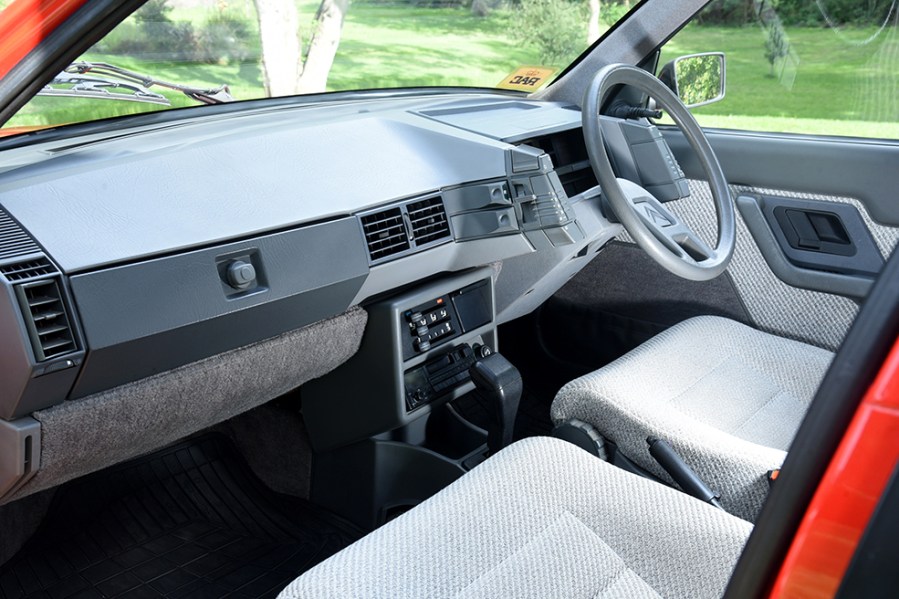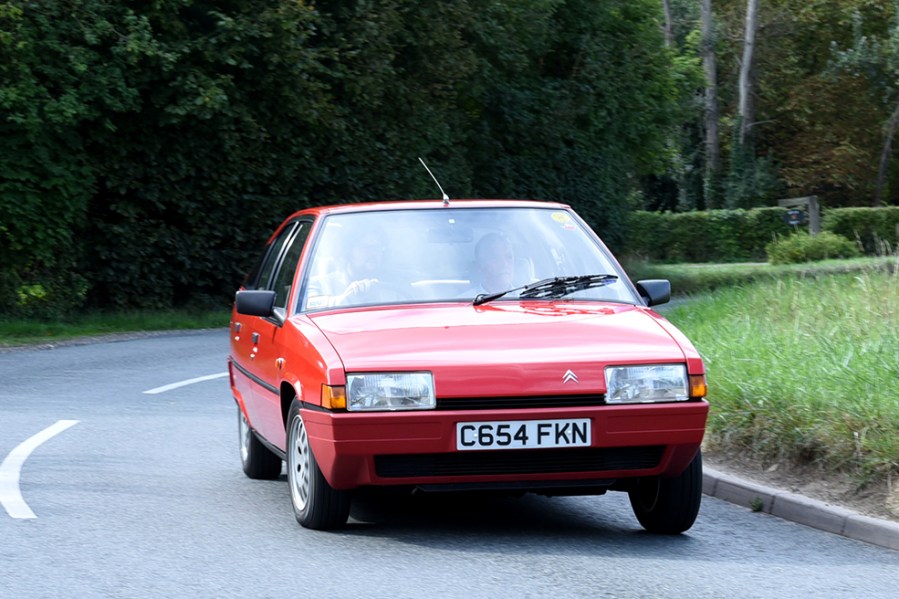The Citroën BX was the first of the brand’s hydropneumatic models to use Peugeot underpinnings. We get behind the (single spoke) wheel
Words: Sam Skelton Images: Paul Walton
While the BX was far from Citroën’s first medium sized family car, it was the first to make any serious headway in the British market. Buyers put off by the GS’s eccentricities took to the Peugeot-inspired relative normality of the BX, and earned the brand a new legion of followers in the process.
The Ford Sierra and Vauxhall Cavalier were able to appeal to the mass market, but the BX offered customers something that was refreshingly different while sharing enough parts with the Peugeot 305 to make ownership a painless proposition. Here at last was a Citroën with hydropneumatic suspension that wouldn’t see the company fleet manager having a heart attack, nor the family man failing to budget enough for its care. Advanced diesel engines only made the package more appealing as time went by, and the BX became something of a cult car with a band of diehard followers who simply wouldn’t consider anything else. As a rep’s car, a family car, even a fun car in the cases of the hot variants, the BX was one of those rare vehicles that could be almost all things to all people. Now it’s turned 40, now is the time to look back, consider that legacy, and work out whether it was really as good as all its supporters suggest.
While you can draw the development story back as far as a pre-PSA Citroën, the BX development story really begins with project XB of 1977 – a new mid-sized car that would use the underpinnings of a similar Peugeot. Designs were submitted from internal and external styling houses – Italdesign’s effort looked very like the subsequent concept Lancia Megagamma – but it was a sharp design from Bertone’s Marcello Gandini that finally won out. Any similarities to the Volvo Tundra concept car can be attributed to the stylist – the BX had already been accepted by the time Tundra was first shown. It was the first project for which Citroën had used CAD (computer-aided design), in order to reduce its reliance on clay models and styling bucks for development purposes, which in turn would save time and money. Several radical interior proposals were offered before a more conventional dash panel was chosen.
In 1981 the BX was shown alongside competitors to potential customers to gauge responses, and the feedback was positive; not only was the car undeniably a new Citroën but it was one that the public wanted. When launched, it was given the name BX – primarily because it sat well between the existing CX and soon-to-be-announced AX supermini. The 1984 estate boosted sales, while the 1986 Digit special edition with a digital dash remained a curiosity.
The 1987 model year saw a facelift, with conventional dials and stalks, new bumpers and wider wings the main giveaways, though other differences became evident once you started replacing panels on used cars. A Series 1 rear door, for instance, differs from a Series 2. New at this time was the GTi – a 125bhp variant using the same 1.9-litre engine fitted to the later iterations of the 205GTi. The BX may have been heavier, but its suspension meant that if anything it could be even quicker down the average French minor road.

The 16-valve added more power still, but it was the Turbo Diesel models of 1988 that really gave the BX a home on the British market – powerful, quiet and economical, they became the ideal cost-efficient transport for people just wanting a comfortable A-B machine, and offered the bonus of amusing handling should it be desired. This was the only diesel in its class that could better the new Montego Turbo Diesel, in a blow for British pride and a further bonus for the French marque’s place on company car lists.
But by 1993, it was over. The new Xantia had been launched that year, based on the newer Peugeot 405 platform – and while the BX estate would continue until the launch of the new Xantia estate in 1994, it was with a reduced range. Entry level BXs had already been replaced in 1991 with the new ZX, and it was this two-model strategy that Citroën would continue to employ into the 21st century. By the end, 2.3 million BXs of all types had been produced.
This beautiful BX16TRS automatic is the property of Ian and Sue Bowen, based near Bury St Edmunds, Suffolk. It was bought new by Ian’s mother for his ill father, and has never left the family. With only 55,000 miles from new, it would be hard to find a better cared-for example or one in better condition – this is as close to a perfect early BX as you will find.
I must confess to a small personal bias here: as a CX, XM and Xantia owner, I’m well-versed in the ways of the big Citroën, and things which to some might seem alien are perfectly normal to me. This might be why the Citroën BX interior feels unexpectedly normal for a pre-1990 Citroën design; with switchgear partially shared with Peugeot stablemates. You have the fingertip rocker switches, minor control satellites and the rotating dial speedometer from the CX, but the rest is almost conventional – and even those features would disappear by the time of the Mk2 BX. The grey trim makes the cabin feel light and airy, the rectilinear dashboard looks good and the tweed seat trim is surprisingly intact despite the passage of time. They’re good, soft seats too in the best French traditions. Even for a six-footer of ample proportions there’s plenty of room up front, with all controls falling exactly where you’d expect them. Those new to Citroën will not be familiar with the height control lever – but as long as it’s in its second position you won’t need to touch this to drive it.
We’re not going to pretend that an automatic family saloon is going to set the world on fire. The Citroën BX sits somewhere between an Escort and a Sierra in size and while a variant of the 1.6-litre XU did go into the Peugeot 205GTi, it wasn’t in this state of tune. But nor is it a slow car, 0-60 in 13.5 seconds is as quick as most of us would reasonably need to go and the car felt more than powerful enough with three adults on board as we drove between locations. The steering is maybe not as sharp as that in a larger CX, but for a 1980s power assisted set-up it’s nicely weighted without being overly light or heavy, and the car changes direction with aplomb. It’s reasonably communicative too, not as numb as the steering in larger Citroëns while sharing their directness, and the weight distribution of the car means you can take advantage of that fact. It doesn’t understeer unduly, and the main limit to cornering speed is the roll that’s inherent in cars with hydropneumatic suspension systems.

Roll can be a real benefit, and it’s in cars like the BX that you feel it working with you to shift the weight into bends. But what makes this car so good in the bends is the grip; grip that can only be maintained by ensuring the wheels remain in contact with the road surface and that the body can’t unduly influence them. This is where a hydropneumatic suspension system really comes into its own – it feels as if body and chassis are almost isolated, the frenetic energy of the one not transferred into the other and the interconnection between front and rear wheels easing and softening the effects of any bumps or undulations. Even the best springing set-ups can’t compete – and the Peugeot variant of this chassis, the 305, has excellent suspension in the conventional sense. It melds ride and handling well, but the BX takes that to a whole new level. I’ve driven many miles in a 305 1.6 automatic, and the BX takes everything that was good about that package and refines it just that little bit more.
It was though, arguably, the beginning of the end for the hydropneumatic Citroën, as the marque became ever more reliant upon the componentry of existing Peugeot models. The next big Citroën, the XM, would again share a Peugeot platform, as would the BX’s replacement in the shape of the Xantia. Two more generations and the Citroën C5’s successor would come only with coil springing; the last hydropneumatic models leaving production in 2017.
Citroën CX: our verdict
We can forgive the Citroën BX for its pivotal role in its manufacturer’s shift to Peugeot reliance; while it ultimately signed the death warrant for Citroën’s independence, it ensured that the company was able to live on to earn legions of new enthusiasts. In the process of normalising the brand it brought in arguably more new customers than any previous mainstream model, and opened the eyes of far more people to the magic of a magic carpet ride than the DS or CX ever could.
And it did so without sacrificing the sort of thinking that challenged accepted wisdom with concepts that become more logical the more you use them. The Citroën BX acted as a bridge between the eccentricities of older Citroëns and the normality of cars like the Ford Escort. There may not be many good examples left but we recommend you get one while you can.

























